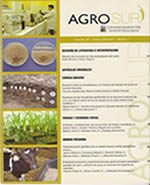Structural stability of an Andisol (Typic Durudand) under native forest and grassland in Southern Chile
Main Article Content
Abstract
The enabling of forests to achieve productive systems is one of the most significant causes of land use change in Southern Chile, and it can be evaluated through changes in soil structure. The structural stability of a volcanic soil and its relationship with the colloidal fraction under forest and grassland was evaluated in this study. Disturbed and undisturbed samples were collected for soil chemical characterization and evaluation of hydraulic and mechanical properties, aditionally qualitative properties of the organic matter were determined, for both uses, at three depths (5, 20 and 50 cm). For the purposes of statistical analysis land use was consider as a factor.
The land use change from grassland to forest caused: i) an increase of 38% in bulk density at 5 cm, an increase of 44% and 75% of the organic matter content at 20 and 50 cm; ii) an increase of 33% allophane at 5 cm and a reduction in the effective porosity of 14% between 5 and 20 cm; iii) an increase of 180% in air permeability at 50 cm, a 54% decrease in the variation of the average diameter of aggregates and a 32% decrease of the repellency index at 5 cm.
Soil physical functioning improved after a land use change. This might be determined by the qualitative properties of soil organic matter and its interaction with the matrix, oxides and hydroxides of Al and Fe.

